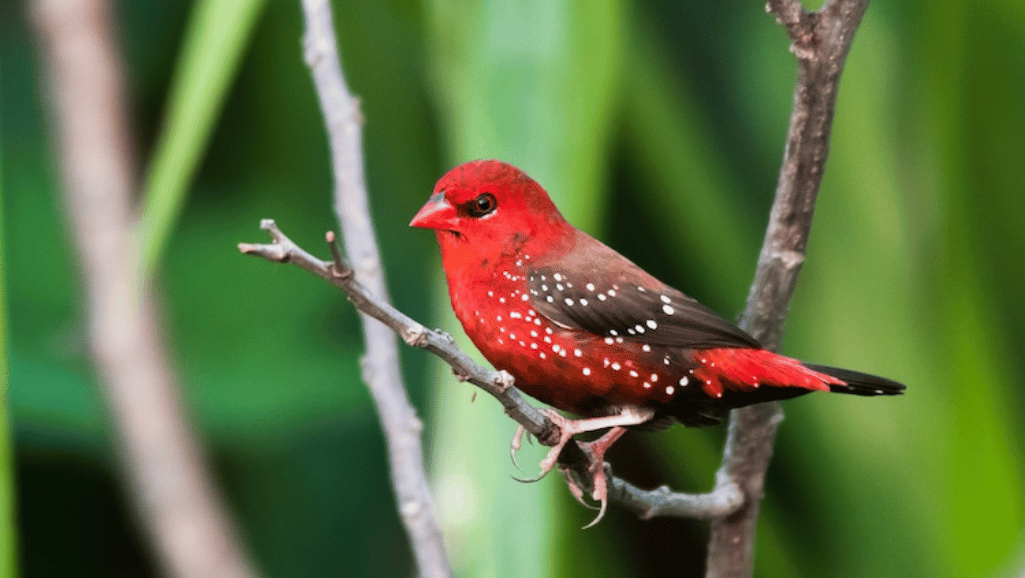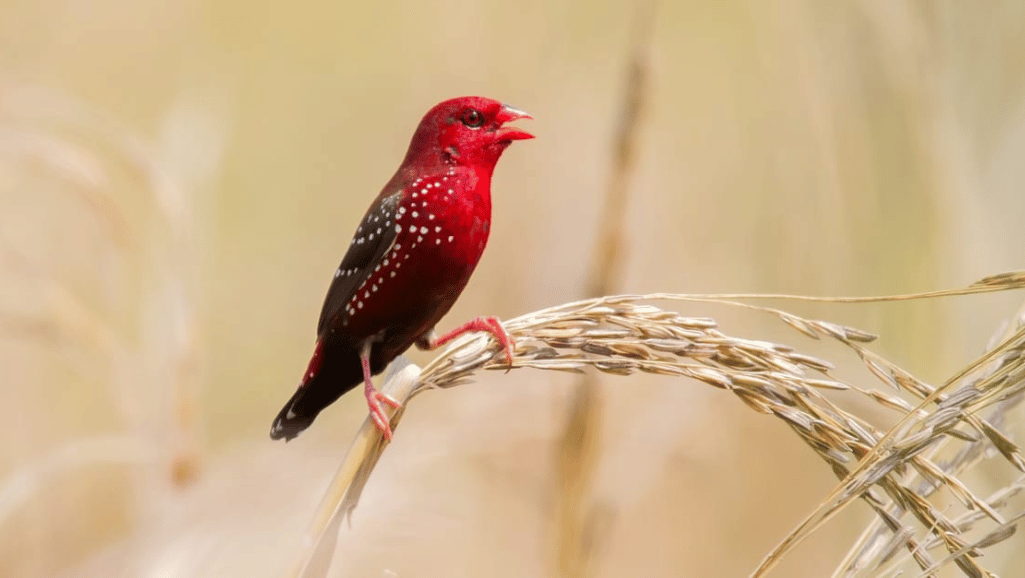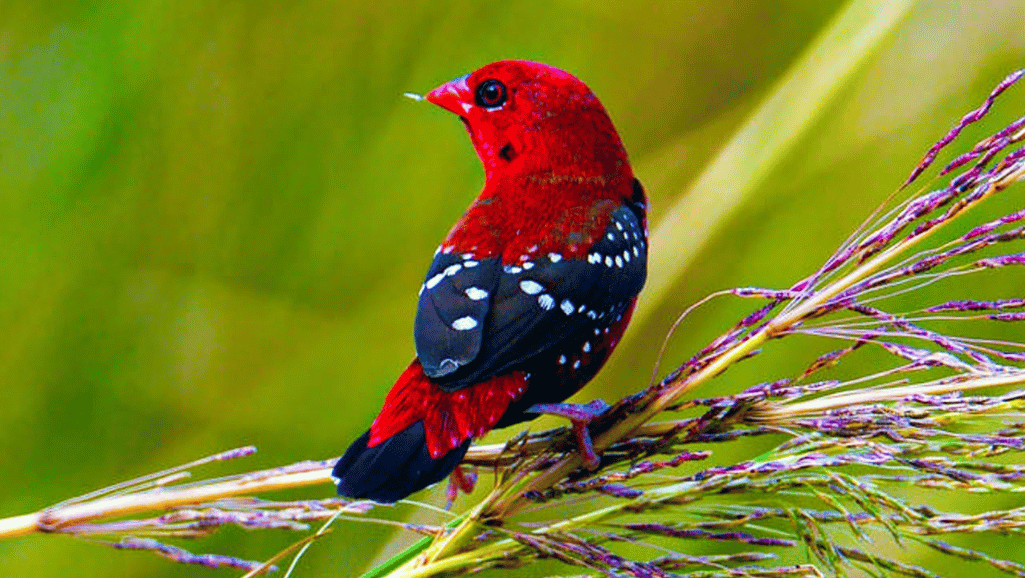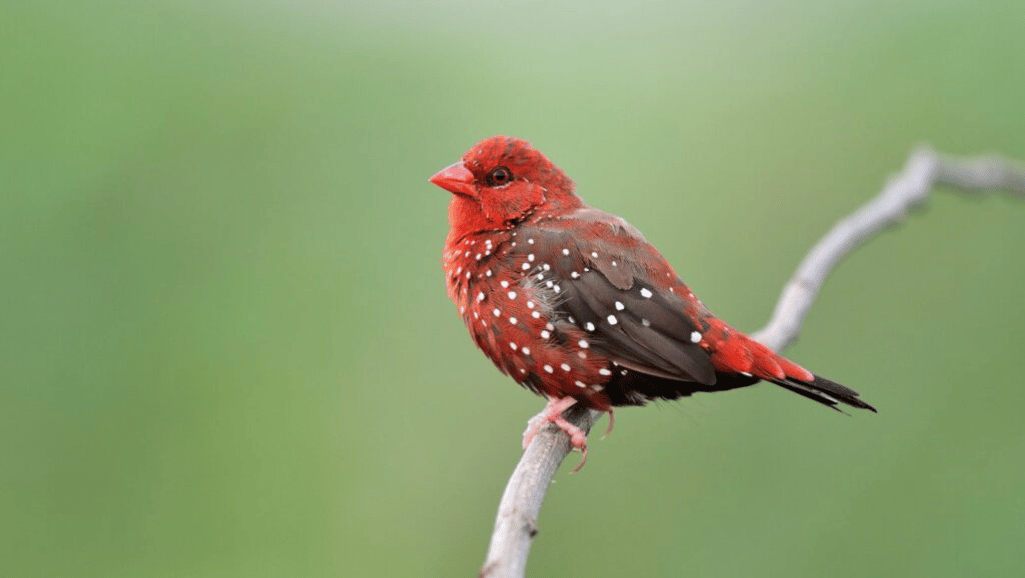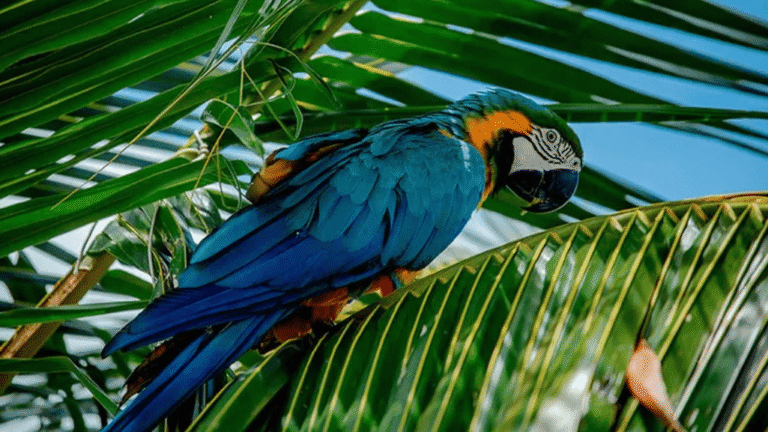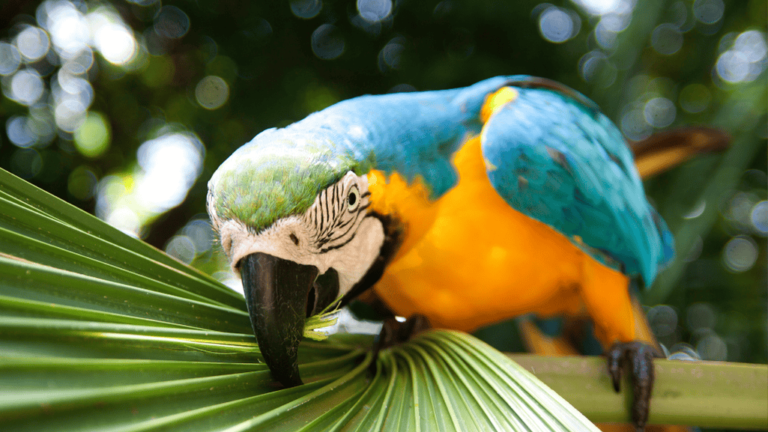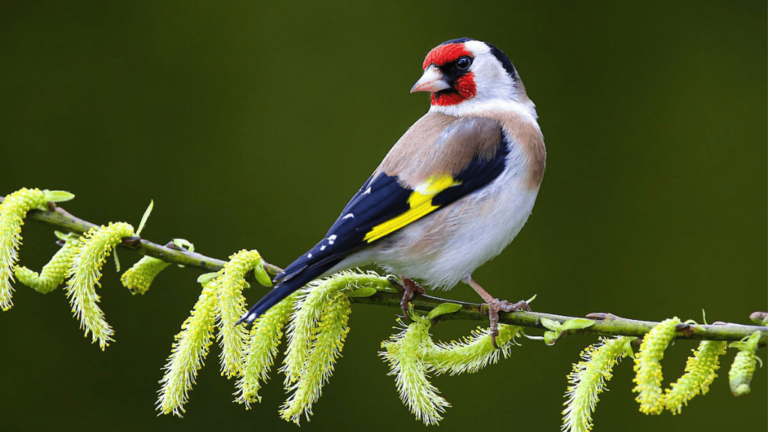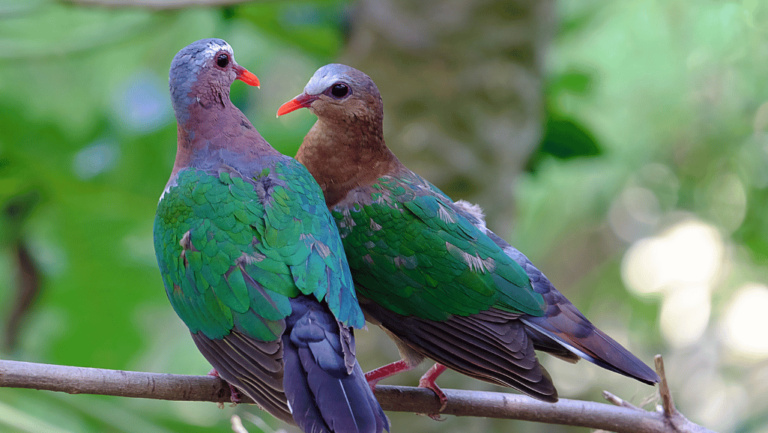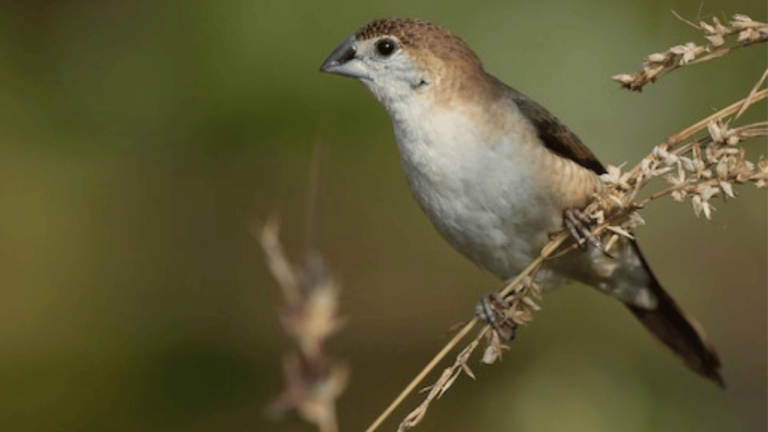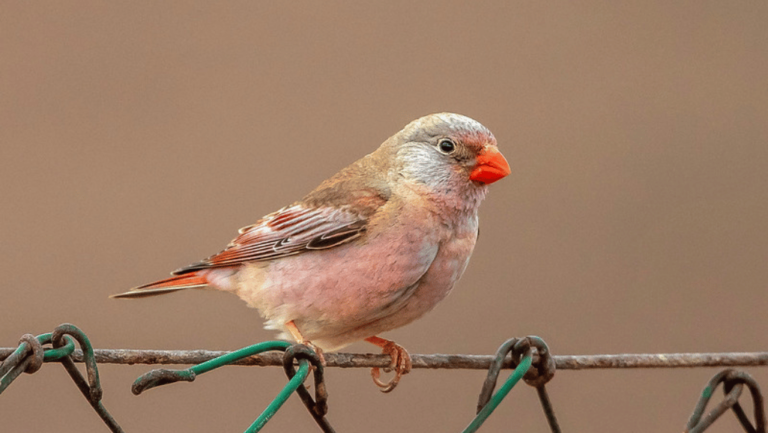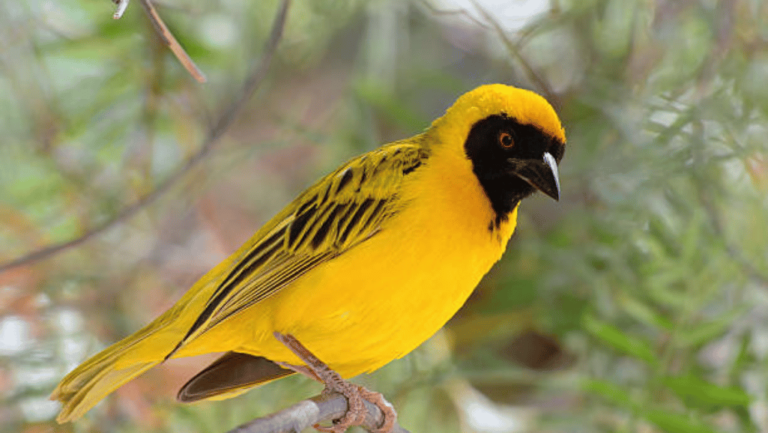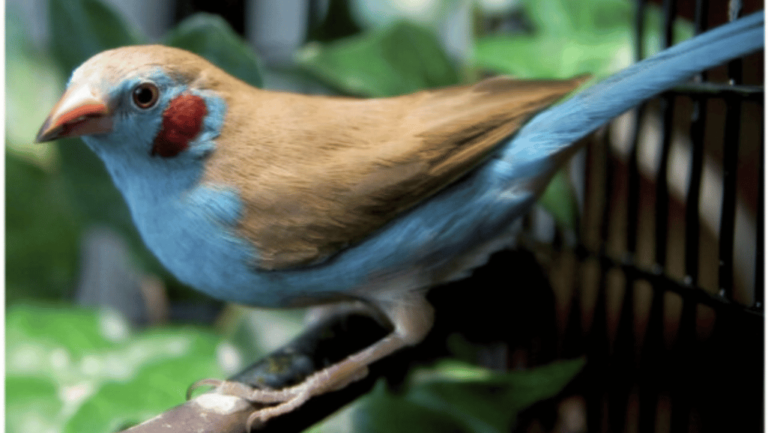Welcome to our article on the Strawberry Finch, also known as the red munia or red avadavat! This small seed-eating songbird is a delightful sight in the tropical regions of Asia, including countries like Bangladesh, India, Sri Lanka, Nepal, and Pakistan. It can also be found in parts of southeast Asia and has been introduced to Hawaii, Fiji, and Malaysia. Known for its vibrant plumage and charming presence, the Strawberry Finch is a favorite among avian enthusiasts and birdwatchers.
As we explore the world of the Strawberry Finch, we will delve into its appearance and breeding season, habitat and distribution, behavior and social structure, conservation and threats, and its unique traits and adaptations. Along the way, we’ll uncover the cultural significance and appreciation for this beautiful bird, as well as the importance of avian biodiversity and the conservation of its natural habitat.
Key Takeaways:
- The Strawberry Finch is a small seed-eating songbird found in tropical Asia.
- Its vibrant plumage and charming presence make it a favorite among avian enthusiasts.
- The Strawberry Finch thrives in habitats such as grasslands, fields, jungle clearings, gardens, and meadows.
- Conservation efforts are crucial to protect the species and its natural habitat.
- Observing and appreciating the beauty of the Strawberry Finch contributes to avian biodiversity awareness.
Appearance and Breeding Season
https://www.youtube.com/watch?v=vIjmTWOV9fU
During the breeding season, male Strawberry Finches display rich red feathers on their crown and back, with scattered white dots on their wings. The underside, breast, and sides of the head of the male bird are a scarlet color. Females also undergo a color change during the breeding season, with a brighter yellow-orange underside. Both males and females change the color of their beaks, with the beak becoming red during the warmer months. Males perform a mating dance, bowing with feathers erect while carrying a blade of grass or a feather in their mouth. Couples pair off to mate and build nests in the grass, typically leaving a clutch of five to six eggs.
| Physical Characteristics | Mating Behavior | Reproductive Cycle |
|---|---|---|
| Male: | Mating dance | Clutch size: 5-6 eggs |
| Red crown and back | Feathers erect | Incubation period: 12-14 days |
| White dots on wings | Carrying blade of grass or feather | Nest building: In grass |
| Scarlet breast and head | ||
| Female: | ||
| Brighter yellow-orange underside | ||
| Beak turns red |
To attract mates, male Strawberry Finches perform an elaborate mating dance, bowing with feathers erect while carrying a blade of grass or a feather in their mouth. Females are drawn to the males with the most vibrant colors and attractive displays. Once paired off, they construct nests in the grass, where the female lays a clutch of five to six eggs. The incubation period lasts for approximately 12 to 14 days. The Strawberry Finch’s breeding season showcases the fascinating displays and behaviors of these Estrildid finches.
Habitat and Distribution
Strawberry Finches thrive in tropical climates and are primarily found in Asia. They prefer habitats such as grasslands, fields, jungle clearings, gardens, and meadows. These diverse environments provide them with an abundance of food sources and nesting opportunities. Their adaptability allows them to thrive in both natural and cultivated areas, making them a common sight in many landscapes.
While their original populations are in Bangladesh, India, Sri Lanka, Nepal, and Pakistan, Strawberry Finches have also been introduced to other regions. Introduced populations can now be found in places like Hawaii, Fiji, and Malaysia, where they have adapted to the local ecosystems.
The conservation status of Strawberry Finches is currently categorized as “least concern” by the IUCN Red List. This classification indicates that their population is healthy and stable in their natural habitats. However, ongoing efforts should be made to monitor their populations and conserve their habitats to ensure their long-term survival.
Migration Patterns
Strawberry Finches are not known for long-distance migrations. Instead, they are generally sedentary birds, staying in or near their preferred habitats throughout the year. However, some localized movements may occur in response to seasonal changes in food availability or breeding conditions.
During these movements, Strawberry Finches may explore neighboring areas in search of suitable nesting sites and food resources. These movements are often short-distance and may involve small groups of birds.
Overall, while Strawberry Finches may exhibit some localized movements, they do not undergo extensive migrations like some other bird species. Their preference for stable habitats contributes to their consistent presence in their native regions.
Behavior and Social Structure
Strawberry Finches are social birds that exhibit intriguing behavior and have a well-defined social structure. They live in small flocks, typically consisting of around 100 individuals. These flocks provide protection and a sense of community for the finches, allowing them to thrive in their natural habitats.
One of the most fascinating aspects of their behavior is their distinctive song, which resembles the delicate sound of tiny silver bells. This captivating melody can often be heard in the areas where they reside. Birdwatchers and enthusiasts are drawn to their unique vocalizations and use them as a way to identify and locate these beautiful finches.
While in flocks, Strawberry Finches engage in various social behaviors, such as foraging together for grass seeds and insects. They are known for their agile movements as they navigate through tall grasses, searching for food. This cooperative behavior allows them to efficiently locate and consume their preferred diet.
During the breeding season, the social dynamics of Strawberry Finches change as they transition from flocks to pairs. Males attract females through their vibrant plumage and intricate mating dance. Their colorful feathers and graceful movements serve as a visual display to impress potential mates. Once a pair is formed, they remain monogamous for the breeding season.
The table below provides a summary of the behavior and social structure of Strawberry Finches:
| Behavior | Social Structure |
|---|---|
| Distinctive song resembling tiny silver bells | Small flocks of around 100 individuals |
| Foraging together for grass seeds and insects | Cooperative behavior within flocks |
| Elaborate mating dance by males | Pair formation during breeding season |
| Monogamous pairs for the breeding season | Temporary shift in social structure |
By observing the behavior and social interactions of Strawberry Finches, birdwatchers can gain insight into the fascinating world of these captivating songbirds.
Conservation and Threats
The Strawberry Finch is currently listed as “least concern” in terms of conservation status. However, like many other bird species, it may face threats such as habitat loss, climate change, and illegal capture for the pet trade. Efforts should be made to protect and conserve their natural habitats, especially in their native range.
Habitat loss poses a significant threat to the Strawberry Finch population. The destruction of grasslands, fields, and meadows impacts their ability to find suitable nesting sites and access food sources. Climate change also plays a role, as shifts in temperature and rainfall patterns can alter the availability of resources.
Illegal capture for the pet trade is another concern. The vibrant plumage and melodious song of Strawberry Finches make them highly sought after as pets. However, capturing and keeping them in captivity disrupts their natural behavior and can have a negative impact on their population.
To ensure the long-term survival of the Strawberry Finch and maintain avian biodiversity, conservation efforts should focus on preserving their habitats and raising awareness about the importance of their role in ecosystems. Implementing measures to reduce habitat loss, such as creating protected areas and promoting sustainable land use practices, is crucial. Additionally, strict enforcement of laws and regulations against the illegal pet trade is essential.
Threats to the Strawberry Finch Population:
- Habitat loss: Destruction of grasslands, fields, and meadows.
- Climate change: Shifts in temperature and rainfall patterns.
- Illegal capture: Demand for the vibrant plumage and melodious song as pets.
Conservation Strategies:
- Protecting natural habitats: Creating and maintaining protected areas.
- Raising awareness: Educating the public about the importance of the Strawberry Finch in ecosystems.
- Enforcing regulations: Combatting the illegal pet trade through strict law enforcement.
By taking these measures, we can contribute to the preservation of the Strawberry Finch population and promote avian biodiversity for future generations.
Introduction to Other Locations
Besides their native range in Asia, Strawberry Finches have been introduced to other locations such as Hawaii, Fiji, and Malaysia. These introduced populations are often found in tropical climates, offering birdwatchers the opportunity to observe the vibrant charm of these finches in non-native habitats.
Strawberry Finches have successfully adapted to these new environments, displaying their colorful plumage and captivating behavior. Whether introduced by human intervention or escaping from captivity, these finches have found suitable conditions in these tropical regions to thrive and establish populations of their own.
Introduction of Strawberry Finches in Different Locations:
| Location | Features |
|---|---|
| Hawaii | Mild tropical climate, diverse vegetation |
| Fiji | Tropical paradise with lush forests and coastal areas |
| Malaysia | Tropical rainforests and diverse ecosystems |
Birdwatchers in these areas can enjoy observing the unique interactions and behaviors of Strawberry Finches outside their native range, expanding our understanding of finch ornithology and contributing to the appreciation of avian biodiversity on a global scale.
Captive Care and Pet Ownership
Strawberry Finches, with their vibrant plumage, are popular pets in certain parts of the world. However, it is crucial to provide them with the necessary care and environment for their well-being. To ensure optimal health, captive birds require a suitable diet consisting of a small seed mix and live food such as mealworms and fruit fly larvae.
Additionally, access to freshwater, cuttlebone, and grit is important for their overall well-being. Freshwater should be provided daily for hydration, while cuttlebone and grit aid in digestion and beak maintenance. Grit is especially important for seed-eating birds, like the Strawberry Finch, to help break down and process their food properly.
Creating a comfortable and stimulating living environment is vital for the happiness of pet Strawberry Finches. They thrive in aviaries or spacious cages that allow them to fly and explore. Providing natural perches, toys, and hiding spots can enrich their environment, keeping them mentally and physically stimulated.
| Essential Care Items for Strawberry Finches: |
|---|
| Small seed mix |
| Live food (mealworms, fruit fly larvae) |
| Freshwater |
| Cuttlebone |
| Grit |
| Spacious aviary or cage |
| Natural perches |
| Enrichment toys |
| Hiding spots |
By providing the proper care and attention, Strawberry Finches can thrive as pets, bringing joy and beauty to their owners. However, it is important to always prioritize their well-being and provide them with an environment that mimics their natural habitat.
The Beauty of Strawberry Finches
The vibrant plumage of the male Strawberry Finch, with its deep red crown and back, white dots, and scarlet coloration, is a sight to behold during the breeding season. The female undergoes a transformation with a brighter yellow-orange underside. Their unique appearance and captivating colors make them a visually striking bird, both in their natural habitats and as pets.
<!–
Table: Comparison of Strawberry Finch Plumage (Male and Female)
| Plumage Feature | Male Strawberry Finch | Female Strawberry Finch |
|---|---|---|
| Crown and Back | A deep red color | Undergoes a transformation with a brighter yellow-orange color |
| White Dots on Wings | Present on wings | Present on wings |
| Underside and Breast | Scarlet color | Undergoes a transformation with a brighter yellow-orange color |
–>
The striking plumage of the Strawberry Finch is not limited to its breeding season. Even outside of breeding, this species maintains a delightful combination of vibrant reds and oranges, adding a touch of color to any environment it inhabits. Their exquisite appearance has captured the awe and admiration of birdwatchers and avian enthusiasts around the world.
Unique Traits and Adaptations
Strawberry Finches, with their fascinating ornithology and specific habitat requirements, possess unique traits and adaptations that enable their survival in diverse environments. These adorable songbirds have evolved distinctive characteristics that aid them in foraging, nesting, and successful reproduction.
1. Small Size and Maneuverability
One of the remarkable adaptations of Strawberry Finches is their petite size, which allows them to navigate through tall grasses, their preferred nesting locations. Their small stature enables them to access hidden food sources and build nests amidst dense vegetation, offering protection from predators.
2. Specialized Diet
The diet of Strawberry Finches mainly comprises grass seeds and insects, providing them with the necessary nutrients for survival. This adaptation allows them to thrive in grasslands, meadows, and jungle clearings where these food sources are abundant. Their ability to efficiently process seeds and insects contributes to their overall reproductive success and population maintenance.
3. Vibrant Plumage for Attraction and Camouflage
During the breeding season, male Strawberry Finches exhibit vibrant plumage with their signature strawberry-like red crown and back, scattered white dots on their wings, and a scarlet hue on their underside and sides of the head. This visually striking appearance serves two purposes. Firstly, it helps attract mates during courtship displays, ensuring successful reproduction. Secondly, the male’s colorful plumage blends with the surrounding foliage, offering them camouflage from predators.
4. Cooperative Breeding and Parental Care
These finches often exhibit cooperative breeding behavior, with additional members of the flock assisting in raising the offspring. This collaboration ensures the survival of young birds by providing enhanced protection and access to food resources. The presence of multiple adults attending the nest reduces the burden on the primary breeding pair and contributes to the overall reproductive success of the species.
5. Adaptability to Changing Environments
Strawberry Finches have demonstrated adaptability to various habitats, allowing them to thrive in a range of environments. From their native range in Asia to introduced populations in tropical locations, these birds display remarkable resilience and the capacity to colonize new areas, provided suitable resources are available.
Overall, the unique traits and adaptations of Strawberry Finches showcase their remarkable ability to survive and flourish in diverse habitats. Their small size, specialized diet, vibrant plumage, cooperative breeding behavior, and adaptability make them an intriguing subject for ornithologists and nature enthusiasts alike.
Cultural Significance and Appreciation
Strawberry Finches, with their vibrant colors, intricate behaviors, and natural charm, have captured the fascination and appreciation of birdwatchers and avian enthusiasts around the world. These beautiful birds are a favorite subject for observation and study, drawing attention with their unique characteristics.
By understanding and appreciating Strawberry Finches, we can contribute to the conservation of their habitats and promote avian biodiversity. Birdwatching finches allows us to immerse ourselves in the wonders of nature and develop a deeper connection with the delicate balance of ecosystems they inhabit.
Benefits of Birdwatching Finches:
- Opportunity to observe and appreciate the beauty of Strawberry Finches in their natural habitats.
- Enhanced understanding of avian biodiversity and the importance of conservation efforts.
- Contribution to scientific research and citizen science initiatives by reporting sightings and behaviors.
- Enjoyment of outdoor activities and exploration of diverse ecosystems.
Appreciating the intricate behaviors of Strawberry Finches, such as their unique courtship rituals, nesting habits, and feeding patterns, offers a glimpse into the fascinating world of avian life. Through birdwatching, we can gain a greater appreciation for the delicate balance of nature and the importance of protecting these habitats for the well-being of all species.
| Benefits of Birdwatching Finches |
|---|
| Opportunity to observe and appreciate the beauty of Strawberry Finches in their natural habitats. |
| Enhanced understanding of avian biodiversity and the importance of conservation efforts. |
| Contribution to scientific research and citizen science initiatives by reporting sightings and behaviors. |
| Enjoyment of outdoor activities and exploration of diverse ecosystems. |
Engaging in birdwatching activities not only brings personal joy and a deeper connection to nature, but it also fosters a sense of responsibility towards the preservation of avian biodiversity. By raising awareness and sharing our passion for birds like the Strawberry Finch, we can inspire others to join in the efforts to conserve these beautiful creatures and the habitats they depend on.
Conclusion
The Strawberry Finch, with its vibrant plumage resembling juicy berries and melodious song, is a captivating bird species that can be found in the tropical regions of Asia. Its unique characteristics, including breeding habits and adaptations to various environments, have piqued the interest of birdwatchers and researchers alike. While some individuals keep these delightful birds as pets, it is essential to prioritize their conservation in the wild to safeguard their natural habitats and contribute to the overall biodiversity of avian species.
By appreciating the beauty and studying the behaviors of Strawberry Finches, we can gain valuable insights into the intricate workings of these remarkable creatures. The birds’ captivating appearance and enchanting song make them a favorite subject for birdwatchers, who eagerly observe them in their native habitats and beyond. Through careful conservation efforts, we can ensure the long-term survival of Strawberry Finches, preserving their presence in the wild for future generations to enjoy.
As we continue to marvel at the splendor of the Strawberry Finch, it is our duty to recognize the importance of protecting not only this species but also the entire ecosystem it inhabits. By promoting birdwatching and conservation efforts, we can raise awareness about the significance of avian biodiversity and take the necessary steps to preserve these remarkable birds for generations to come.
FAQ
What is a Strawberry Finch?
The Strawberry Finch, also known as the red munia or red avadavat, is a small seed-eating songbird found in tropical Asia.
Where can Strawberry Finches be found?
They are primarily found in countries like Bangladesh, India, Sri Lanka, Nepal, and Pakistan. However, they have also been introduced to Hawaii, Fiji, and Malaysia.
What is the breeding season of Strawberry Finches?
During the breeding season, male Strawberry Finches display rich red feathers on their crown and back, while females undergo a color change with a brighter yellow-orange underside.
Where do Strawberry Finches prefer to live?
They prefer habitats such as grasslands, fields, jungle clearings, gardens, and meadows.
How do Strawberry Finches behave?
Strawberry Finches are social birds that live in small flocks and feed on grass seeds and insects. They separate into pairs during the breeding season and males attract females through their colorful plumage and mating dance.
What is the conservation status of the Strawberry Finch?
The conservation status of Strawberry Finches is currently categorized as “least concern” by the IUCN Red List, indicating a healthy and stable population.
Are there introduced populations of Strawberry Finches?
Yes, besides their native range in Asia, Strawberry Finches have been introduced to locations such as Hawaii, Fiji, and Malaysia.
Can Strawberry Finches be kept as pets?
Yes, they are popular pets in some parts of the world. However, proper care should be taken to provide a suitable habitat and diet for their well-being.
What is unique about the appearance of Strawberry Finches?
The vibrant plumage of the male Strawberry Finch, with its deep red crown and back, white dots, and scarlet coloration, is a sight to behold during the breeding season.
What adaptations do Strawberry Finches have?
Their small size allows them to maneuver through tall grasses, which are their preferred nesting locations. They have also evolved a diet primarily consisting of grass seeds and insects.
Why are Strawberry Finches appreciated?
Strawberry Finches have captured the fascination and appreciation of birdwatchers and avian enthusiasts around the world due to their vibrant colors, intriguing behaviors, and natural charm.


